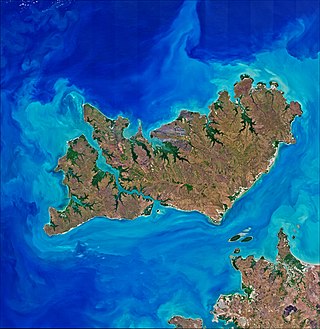
Darwin is the capital city of the Northern Territory, Australia. The city has nearly 53% of the Northern Territory's population, with 139,902 at the 2021 census. It is the smallest, wettest, and most northerly of the Australian capital cities and serves as the Top End's regional centre.

Bathurst Island is one of the Tiwi Islands in the Northern Territory off the northern coast of Australia along with Melville Island.

The Tiwi Islands are part of the Northern Territory, Australia, 80 km (50 mi) to the north of Darwin adjoining the Timor Sea. They comprise Melville Island, Bathurst Island, and nine smaller uninhabited islands, with a combined area of 8,320 square kilometres (3,212 sq mi).
The Northern Land Council (NLC) is a land council representing the Aboriginal peoples of the Top End of the Northern Territory of Australia, with its head office in Darwin.

Tiwi is an Australian Aboriginal language spoken by the Tiwi people on the Tiwi Islands, within sight of the coast of northern Australia. It is one of about 10% of Australian languages still being frequently learned by children.

The Iwaidjan or Yiwaidjan languages are a small family of non-Pama–Nyungan Australian Aboriginal languages spoken in the Cobourg Peninsula region of Western Arnhem Land.

Leichhardtia australis, commonly known as the bush banana, silky pear or green vine is an Australian native plant. It is found in Central Australia and throughout Western Australia. It is a bush tucker food used by Indigenous Australians.
Milikapiti is a village on the northern coast of Melville Island, Northern Territory, Australia. At the 2011 census, Milikapiti had a population of 447.

Atalaya is a genus of eighteen species of trees and shrubs of the plant family Sapindaceae. As of 2013 fourteen species grow naturally in Australia and in neighbouring New Guinea only one endemic species is known to science. Three species are known growing naturally in southern Africa, including two species endemic to South Africa and one species in South Africa, Eswatini and Mozambique.

The Tiwi people are one of the many Aboriginal groups of Australia. Nearly 2,000 Tiwi people live on Bathurst and Melville Islands, which make up the Tiwi Islands, lying about 48 kilometres from Darwin. The Tiwi language is a language isolate, with no apparent link to the languages of Arnhem Land on the Australian mainland. Their society is based on matrilineal descent, and marriage plays a very important part in many aspects of their lives. Art and music form an intrinsic part of their societal and spiritual rituals as the Tiwi people tend to follow a certain form of indigenous Animist belief system. The Stolen Generations saw many Indigenous people brought to the Tiwi Islands who were not of direct Tiwi descent.

Aegiceras is a genus of trees and shrubs from Southeast Asia, Malesia, Australia and the Pacific Island,. and in Australia, in the Northern Territory, Queensland, New South Wales, and Western Australia. They occur as mangroves in coastal or estuarine areas.

An Indigenous Protected Area (IPA) is a class of protected area used in Australia; each is formed by voluntary agreement with Indigenous Australians, and declared by Aboriginal Australians and Torres Strait Islander representative organisations. Each is formally recognised by the Australian Government as being part of its National Reserve System. The areas may comprise land and sea, and are managed by Indigenous groups for the conservation of biodiversity. Managing IPAs also helps to protect the cultural values of their country for future generations, and has benefits for Indigenous health, education, economic and social cohesion.
Jaminjung is a moribund Australian language spoken around the Victoria River in the Northern Territory of Australia. There seems to be a steady increase in the number of speakers of the language with very few people speaking the language in 1967, about 30 speakers in 1991, and between 50 and 150 speakers in 2000.
Land councils, also known as Aboriginal land councils, or land and sea councils, are Australian community organisations, generally organised by region, that are commonly formed to represent the Indigenous Australians who occupied their particular region before the arrival of European settlers. They have historically advocated for recognition of traditional land rights, and also for the rights of Indigenous people in other areas such as equal wages and adequate housing. Land councils are self-supporting, and not funded by state or federal taxes.
Alawa (Galawa) is a moribund Indigenous Australian language spoken by the Alawa people of the Northern Territory. In 1991, there were reportedly 18 remaining speakers and 4 semi-speakers.

Lysiana subfalcata, common name Northern mistletoe, is a spreading to pendulous hemi-parasitic shrub in the Loranthaceae which occurs in all mainland states of Australia except Victoria.

Vernon Islands, also known as the Potinga Islands, is an island group in the Northern Territory of Australia located in the Clarence Strait about 55 kilometres (34 mi) north-east of the territory capital of Darwin. The group consists of three islands which were first sighted by Europeans in 1818 on a British navy ship under the command of Phillip Parker King. The group were part of the subject of a successful aboriginal land claim which was resolved after 40 years in 2018 when the Tiwi people received title. All three islands host navigation aids which assist vessels passing through the Clarence Strait. It and some adjoining seabed have had protected area status since 1974 and which has been known as the Vernon Islands Conservation Reserve since 1979. Since 2007, the island group has been located in the locality of Vernon Islands.
Amyema thalassia is a species of mistletoe in the family Loranthaceae native to Western Australia and the Northern Territory.
Phyllis Jane Fromont is a New Zealand and Australian scientist specialising in sponges.

Atalaya brevialata is a species of plant in the soapberry (Sapindaceae) family. It is native to northern Australia where it occurs in the Northern Territory.











